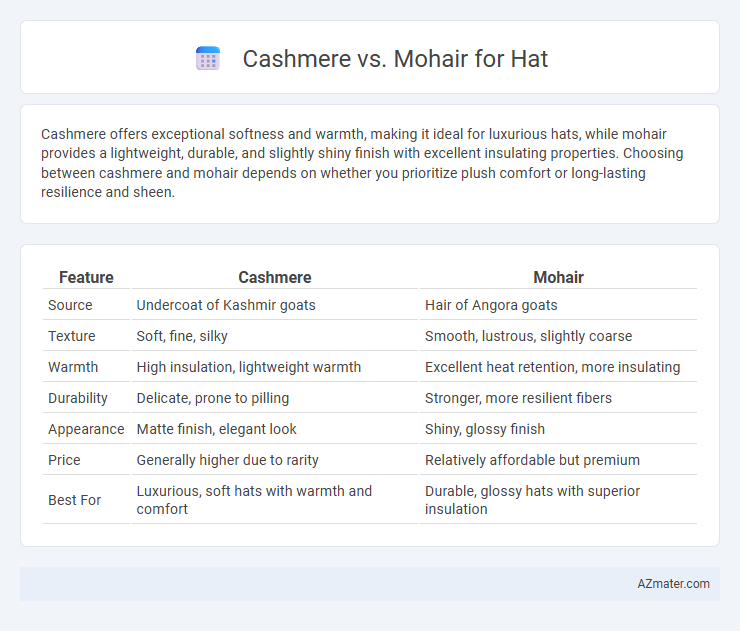Cashmere offers exceptional softness and warmth, making it ideal for luxurious hats, while mohair provides a lightweight, durable, and slightly shiny finish with excellent insulating properties. Choosing between cashmere and mohair depends on whether you prioritize plush comfort or long-lasting resilience and sheen.
Table of Comparison
| Feature | Cashmere | Mohair |
|---|---|---|
| Source | Undercoat of Kashmir goats | Hair of Angora goats |
| Texture | Soft, fine, silky | Smooth, lustrous, slightly coarse |
| Warmth | High insulation, lightweight warmth | Excellent heat retention, more insulating |
| Durability | Delicate, prone to pilling | Stronger, more resilient fibers |
| Appearance | Matte finish, elegant look | Shiny, glossy finish |
| Price | Generally higher due to rarity | Relatively affordable but premium |
| Best For | Luxurious, soft hats with warmth and comfort | Durable, glossy hats with superior insulation |
Introduction to Cashmere and Mohair Hats
Cashmere hats, made from the soft undercoat of cashmere goats, offer exceptional warmth, lightweight comfort, and a luxurious feel ideal for cold weather. Mohair hats, derived from the hair of the Angora goat, are known for their durability, sheen, and excellent insulation properties, making them a stylish and functional choice. Both fibers provide unique benefits, but cashmere excels in softness while mohair delivers long-lasting resilience in hat craftsmanship.
Origin and Source of Cashmere vs Mohair
Cashmere originates from the undercoat of the Cashmere goat primarily found in regions like Mongolia, China, and Nepal, renowned for its softness and insulating properties. Mohair is derived from the Angora goat, mainly raised in South Africa, Turkey, and the United States, prized for its sheen and durability. Both fibers come from distinct goat breeds, with Cashmere offering finer, warmer wool and Mohair providing silkier, more resilient fabric for hats.
Texture and Softness Comparison
Cashmere offers exceptional softness with a fine, smooth texture that feels luxuriously gentle against the skin, making it ideal for comfortable hat wear. Mohair, derived from the Angora goat, provides a silky sheen and a slightly coarser texture with more durability and a subtle loft, giving hats a distinctive, lightweight warmth. While cashmere excels in softness, mohair's unique fiber structure ensures added resilience and a stylish, glossy finish.
Warmth and Insulation Properties
Cashmere offers superior warmth and insulation due to its fine, soft fibers that trap heat efficiently, making it ideal for cold-weather hats. Mohair, derived from the Angora goat, provides excellent durability and moisture-wicking properties but is slightly less insulating than cashmere. Both fibers enhance thermal regulation, yet cashmere excels in maintaining warmth in extremely low temperatures.
Durability and Longevity
Cashmere and mohair are both luxurious fibers, but mohair offers superior durability and longevity for hats due to its strong, resilient fibers that resist wear and maintain shape over time. Cashmere, while incredibly soft and warm, is more delicate and prone to pilling and fiber breakage, requiring gentler care to prolong its lifespan. Hats made from mohair provide a long-lasting investment with enhanced resistance to stretching and abrasion compared to cashmere alternatives.
Allergenicity and Skin Sensitivity
Cashmere and mohair differ significantly in allergenicity and skin sensitivity, with cashmere generally being softer and less likely to cause irritation due to its fine, smooth fibers derived from cashmere goats. Mohair, sourced from the Angora goat, has a coarser texture and may trigger skin sensitivity or allergic reactions in individuals prone to wool allergies because of its larger diameter fibers and lanolin content. For those with sensitive skin, cashmere hats provide a hypoallergenic option with exceptional softness, while mohair hats may require more careful consideration to avoid discomfort.
Breathability and Comfort
Cashmere and mohair both offer exceptional breathability and comfort for hats, with cashmere providing a softer, finer fiber ideal for sensitive skin and lightweight insulation. Mohair, derived from the Angora goat, boasts superior moisture-wicking properties and durability, making it breathable yet slightly coarser than cashmere. Choosing between cashmere and mohair depends on whether softness or enhanced ventilation and resilience are prioritized in hat performance.
Style and Color Options
Cashmere hats offer a luxurious, smooth texture with a natural luster, available in a rich palette of neutral tones such as beige, gray, and black, making them ideal for classic and elegant styles. Mohair hats provide a distinctive sheen and lightweight fluffiness, often found in vibrant hues and gradient patterns, perfect for bold, fashion-forward looks. The choice between cashmere and mohair allows wearers to balance refined sophistication with playful texture and color variety.
Care and Maintenance Tips
Cashmere hats require gentle hand washing with cold water and a mild detergent to maintain softness and prevent fiber damage. Mohair hats benefit from airing out regularly to reduce odors and occasional brushing with a soft garment brush to remove lint and maintain the fabric's natural sheen. Both fibers should be stored in a cool, dry place away from direct sunlight to avoid weakening the fibers and color fading.
Price and Value Differences
Cashmere hats typically command higher prices due to the luxury fiber's softness, rarity, and insulation properties, resulting in a greater initial investment compared to mohair. Mohair hats tend to be more affordable while offering durability and a lustrous sheen, providing strong value for budget-conscious consumers. The choice between cashmere and mohair hats balances luxury and cost, with cashmere delivering premium comfort and mohair emphasizing affordability and resilience.

Infographic: Cashmere vs Mohair for Hat
 azmater.com
azmater.com